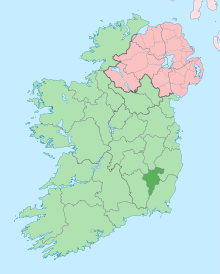2008 Irish pork crisis
Countries affected include: Italy, Germany, the Netherlands, Poland, Sweden, Denmark, Belgium, Estonia, the UK, France, Portugal, Cyprus, Romania, Russia, the United States, Canada, Switzerland, China, South Korea, Japan and Republic of Singapore.
[7][8] On 25 January 2009, Chinese quarantine authorities seized over 23 tonnes of frozen and contaminated Irish pork which was imported by a company in the city of Suzhou in October 2008.
[10] On the evening of 6 December, the Food Safety Authority of Ireland ordered the recall, withdrawal and destruction of all Irish pork products dating back to 1 September.
The Irish general public were advised to destroy all their purchased pork products as Ireland's Department of Agriculture and the Food Safety Authority had initiated an investigation.
[17] On the afternoon of 7 December, the FSAI claimed identification of the source as a contaminated ingredient which had been added to pork feed, and said it was now considered that the profile of dioxins located is similar to those found in electronic transformer oils.
[18] On the evening of that same day, RTÉ, the state-run broadcaster, reported that the source of the crisis was a processing plant in County Carlow (see #Millstream Power Recycling Limited).
[14] The Association of Pigmeat Processors refused to continue slaughtering pigs, insisting they needed a massive financial package (up to €1 billion) from the Irish government to assist them with the mass recall.
Much of the hazard posed by dioxins and PCBs comes from their environmental persistence and their lipophilic nature, resulting their propensity to accumulate in the food chain, particularity in the fat of animals.
The maximum dioxin contamination measured in Irish pork was 0.2 ng/g TEQ fat (200 ppt),[2] equivalent to dispersing 10 drops of TCDD throughout a 2.5 million litre Olympic sized swimming pool.
[34] The owner of Millstream Power Recycling Limited was named as 43-year-old man Robert Hogg,[35] who their website explains is their founder,[32] and who got permission to "erect an agricultural feed store" in Clohamon, Bunclody in early 2004.
[39] The remainder is exported, heavily to the neighbouring territories of Northern Ireland and Britain, but it also features in grocery stores and processed meats throughout two continents – Europe and Asia.
[42] Workers in the pork industry who were laid off in the wake of the crisis, including those from affected plants in Edenderry, Waterford and Kilkenny, were carried out a lunchtime protest at Leinster House (government buildings in Dublin) on 11 December.
[46] Within hours a number of local newspapers in Ireland including the Longford Leader[47] and the Leitrim Observer[48][failed verification] had reproduced copies of the same Press Association article.
Speaking on RTÉ Radio on the morning after the initial announcement, Deputy chief executive of the FSAI, Alan Reilly said it was "necessary as a precautionary measure" to remove all pork products from within the country.
He said he "expected" pork products to be available again before the busy Christmas period got underway and is scheduled to meet government officials and retailers within hours.
[54] The UK's Food Standards Agency has said it does not believe its country's consumers face "significant risk" but it was still awaiting confirmation from the Irish authorities that the affected products had not been exported to its neighbour.
[55] Chief Scientist Andrew Wadge stated on his FSA blog that because dioxins remain in the body for approximately 30 years, exceeding regulatory limits for a few days has an "insignificant" effect on the individual consumer.
CNN tagged the story as "another red flag being waved over dinner tables this week with warnings from the Irish government not to eat its pork products", comparing the crisis to bovine spongiform encephalopathy, bird flu and the 2008 Chinese milk scandal.
[63] The UK's Food Standards Agency was conducting tests to assess the level of dioxins present in Northern Irish cattle herds.
Northern Ireland's Minister of Health, Social Services and Public Safety, Michael McGimpsey has announced restrictions on milk supplies in the province.
[66] The EFSA calculated a number of different exposure scenarios, and they found that if a consumer ate Irish pork each day over the 90-day period, 10% of which was contaminated, the "increase in the body burden [would be] of no concern for this single event".
In the "very extreme case" of eating large amounts of 100% contaminated Irish pork every day over the 90-day period in question, the EFSA considered that "this unlikely scenario would reduce protection, but not necessarily lead to adverse health effects".



The smallest green circle represents the legal limit.
The other circles' areas are relative to the green circle and represent the lowest (80 times the legal limit) and highest (400 times the legal limit) levels of dioxin found in Irish pork and beef.


